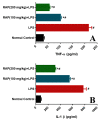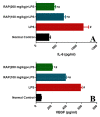Therapeutic Potential of Rhododendron arboreum Polysaccharides in an Animal Model of Lipopolysaccharide-Inflicted Oxidative Stress and Systemic Inflammation
- PMID: 33371296
- PMCID: PMC7767231
- DOI: 10.3390/molecules25246045
Therapeutic Potential of Rhododendron arboreum Polysaccharides in an Animal Model of Lipopolysaccharide-Inflicted Oxidative Stress and Systemic Inflammation
Abstract
Systemic inflammation results in physiological changes, largely mediated by inflammatory cytokines. The present investigation was performed to determine the effect of Rhododendron arboreum (RAP) on inflammatory parameters in the animal model. The RAP (100 and 200 mg/kg) were pre-treated for animals, given orally for one week, followed by lipopolysaccharide (LPS) injection. Body temperature, burrowing, and open field behavioral changes were assessed. Biochemical parameters (AST, ALT, LDH, BIL, CK, Cr, BUN, and albumin) were done in the plasma after 6 h of LPS challenge. Oxidative stress markers SOD, CAT, and MDA were measured in different organs. Levels of inflammatory markers like tumor necrosis factor-alpha (TNF-α), interleukin-1-beta (IL-1β) and, interleukin-6 (IL-6) as well as VEGF, a specific sepsis marker in plasma, were quantified. The plasma enzymes, antioxidant markers and plasma pro-inflammatory cytokines were significantly restored (p < 0.5) by RAP treatment, thus preventing the multi-organ and tissue damage in LPS induced rats. The protective effect of RAP may be due to its potent antioxidant potential. Thus, RAP can prevent LPS induced oxidative stress, as well as inflammatory and multi-organ damage as reported in histopathological studies in rats when administered to the LPS treated animals. These findings indicate that RAP can benefit in the management of systemic inflammation from LPS and may have implications for a new treatment or preventive therapeutic strategies with an inflammatory component.
Keywords: Rhododendron arboreum polysaccharides; animal model; lipopolysaccharide; multi-biomarker approach; oxidative stress.
Conflict of interest statement
The authors declare no conflict of interest.
Figures







References
MeSH terms
Substances
Grants and funding
LinkOut - more resources
Full Text Sources
Other Literature Sources
Research Materials
Miscellaneous

